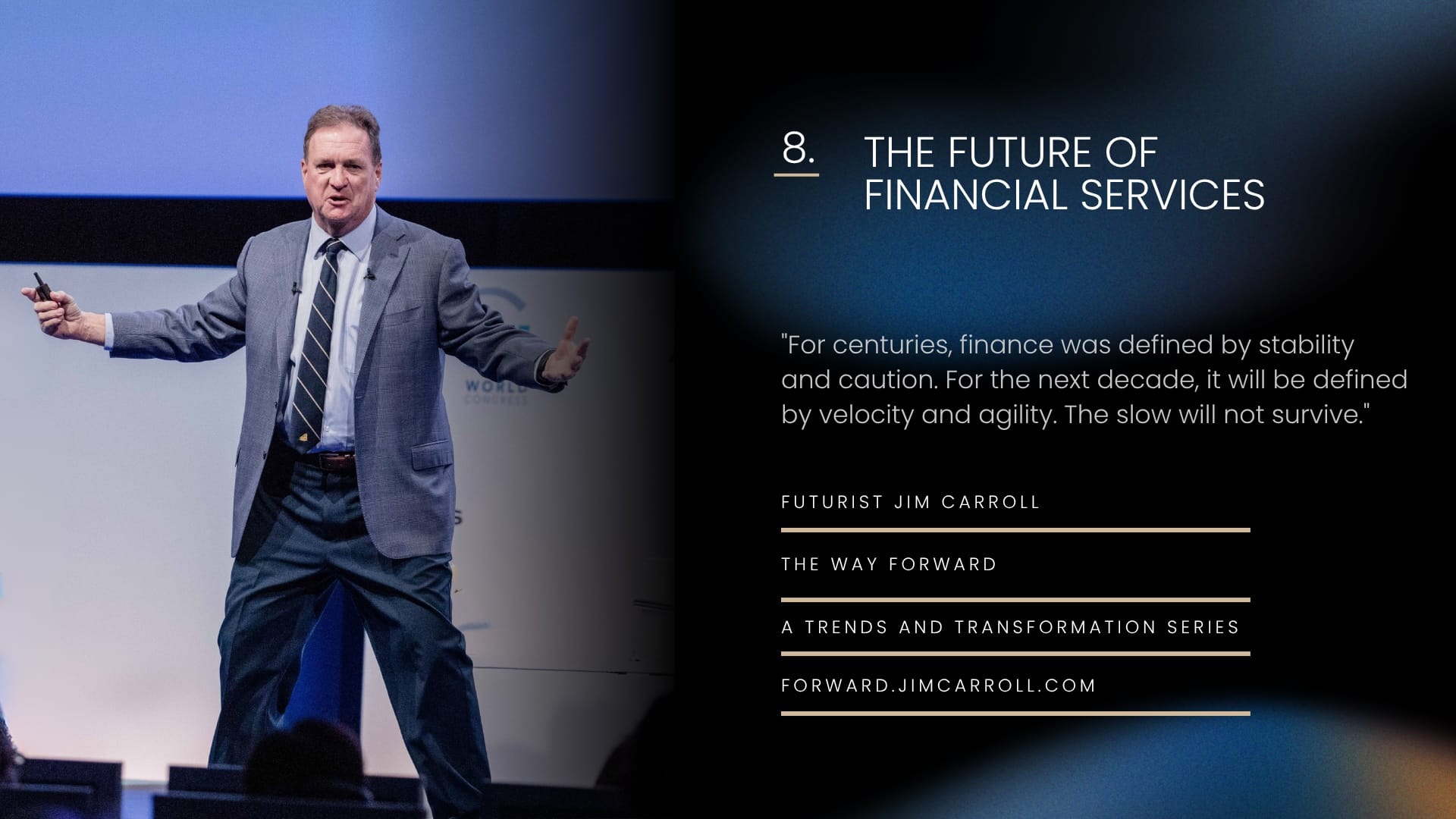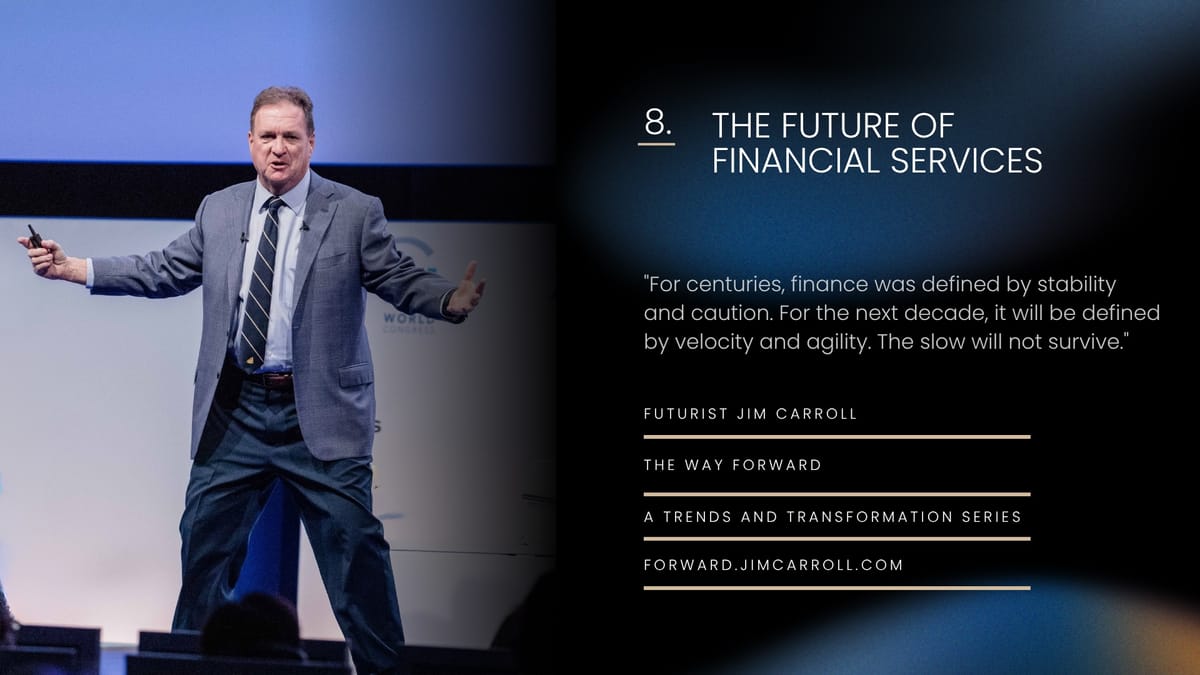“For centuries, finance was defined by stability and caution. For the next decade, it will be defined by velocity and agility. The slow will not survive." - Futurist Jim Carroll

In 2025, the headwinds are severe, and the path forward seems shrouded in fog. We’re living through one of the most volatile and unpredictable periods in recent memory. With that being the case, I am writing this new series, The Way Forward: A Trends and Transformation Series, taking a look at the trends redefining industries, and actionable strategies organizations must pursue to align with these realities. The entire series will be found at forward.jimcarroll.com
The financial services industry, an institution built on centuries of tradition and perceived stability, is in the midst of its most profound and disruptive transformation in history.
The very concept of money, the nature of a transaction, and the role of the institutions that manage our wealth are being fundamentally reimagined. A powerful convergence of mobile technology, artificial intelligence, and a new generation of digital-native competitors is dismantling old certainties and creating a new, high-velocity financial industry where speed matters!
The shifting landscape: 10 trends redefining financial services
To succeed in this new environment, one must first understand the powerful currents reshaping the entire industry, from retail banking to global investment.
- The AI imperative. Artificial intelligence has transcended its role as a back-office tool to become a core driver of front-office strategy, product innovation, and customer engagement, moving the industry toward a new phase of cognitive finance.
- The blockchain promise. Beyond cryptocurrencies, the underlying distributed ledger technology (DLT) is poised to rewire the foundational infrastructure of finance, providing a secure, transparent, and tamper-proof system for transactions and asset management.
- The API economy & open banking. Application Programming Interfaces (APIs) have become the central nervous system of modern finance, enabling a fundamental shift from a closed, product-centric model to an open, customer-centric platform ecosystem.
- The FinTech vanguard. The traditional banking monopoly is continually being challenged by agile startups ("FinTechs") who win by identifying and obsessively solving a specific, unmet customer need with a superior user experience.
- The acceleration of risk. The pace of change is creating new, complex forms of risk, from AI-driven fraud to the looming existential threat of quantum computing to the cryptographic foundations of modern finance.
- The empowered, digital-native customer. The next generation of customers expects a seamless, intuitive, and personalized digital experience, forcing a massive shift away from branch-centric models.
- The reinvention of wealth management. The traditional advisory model is being disrupted by "robo-advisors," while a new generation of investors demands greater transparency, sustainable investment options, and collaborative digital tools.
- The human capital deficit. As banking becomes a technology industry, the required skills are changing dramatically, creating a critical and widening talent and skills gap in areas like data science and AI.
- The new battleground of data. In a digital-first world, the ability to ethically collect, analyze, and act on customer data is becoming the key differentiator, enabling hyper-personalized products and more accurate risk assessment.
- The great generational wealth transfer. A multi-trillion-dollar transfer of wealth from Baby Boomers to their Millennial and Gen Z heirs is underway, creating a massive new client base with fundamentally different values and expectations.
A Deeper Dive: The Forces Reshaping Finance
While all ten trends are critical, a few stand out for their immediate and profound impact. Their convergence is creating a powerful, self-perpetuating flywheel of innovation.
The AI Imperative: From Operational Efficiency to Cognitive Finance
AI and machine learning have become a core driver of strategy, given the role of AI in analyzing vast volumes of information.
The most immediate impact has been in process automation. By automating manual, data-intensive tasks, firms are achieving significant gains in speed and accuracy. For instance, QuickLoan Financial transformed its loan approval process by adopting an AI model, resulting in a 40% decrease in loan processing time and a 25% improvement in detecting high-risk applications.
Beyond efficiency, AI is reshaping investment strategies. The ability of algorithms to analyze massive datasets in fractions of a second allows firms to move from reactive to predictive decision-making. CapitalGains Investments, facing a volatile market, implemented an AI-driven platform for real-time market analysis and achieved a 20% increase in annual returns for its clients.
The Blockchain Promise: Building Trust in a Decentralized World
Blockchain and distributed ledger technology (DLT) are poised to rewire the foundational infrastructure of finance. It's a new form of 'accounting' and settlement that promises to change everything, although implementation will be complex and time-consuming.
How signfiicant?The global FinTech blockchain market, valued at $7.2 billion in 2023, is forecast to reach $325.6 billion by 2033. Trade finance has emerged as a prime use case.
The API Economy: Open Banking and Platform-Based Ecosystems
Application Programming Interfaces (APIs) have become the central nervous system of the modern financial ecosystem. API's allow others to write code and develop applications that link to the financial data of another organization, allowing the development of all kinds of new business models.
Companies like Plaid have built entire businesses on providing the API infrastructure that connects thousands of financial apps—including Venmo, Coinbase, and Robinhood—to users' bank accounts.
For incumbents, embracing the API economy requires a disciplined approach. Mastercard's Developers platform, which offers a wide range of APIs for payments, security, and data services, is a gold standard, generating both direct revenue and indirect value by strengthening its partner network.
The FinTech Vanguard: Analyzing the Business Models of Industry Disruptors
A new generation of FinTech companies has fundamentally altered the competitive landscape and will continue to do so.
Their success comes not from a single piece of revolutionary technology, but from applying existing technologies to solve a specific customer problem with a radically better user experience. In payments, Square democratized card acceptance for small businesses, while Stripe made it radically simple for developers to handle online payments. In lending, Klarna popularized the "Buy Now, Pay Later" (BNPL) model, reducing checkout friction for online shoppers.
In investing, Robinhood eliminated a significant barrier to entry with its commission-free trading model. The common thread is a relentless focus on a customer pain point.
The Incumbent's Dilemma: Deconstructing Barriers to Transformation
While the technological frontier of finance is expanding at an unprecedented pace, the ability of traditional institutions to navigate this new landscape is constrained by a powerful set of internal and external barriers.
- The crippling effect of legacy systems: Like other industries, at the heart of the innovation challenge lies a technical reality: operations are built upon legacy core systems that have become the single greatest bottleneck to digital transformation. COBOL!!!! These systems, often comprising mainframes running decades-old code, are architecturally misaligned with the demands of the modern digital economy. They create integration barriers, data constraints, and slow development cycles, with up to 90% of the IT budget consumed simply by maintenance.
- The culture conundrum: The financial services industry is, by its nature, focused on managing risk. However, a healthy culture of prudent risk management can curdle into a pervasive risk aversion that stifles experimentation. A 2025 survey of UK bank innovation leaders found that 71% believe a "risk-averse culture and red tape kill experimentation, making innovation impossible."
- The innovator's trap: The very management practices that have made a company successful—listening to customers and investing in continuous product improvement—can also be the cause of its eventual failure. Incumbents are rationally driven to invest in "sustaining innovations" for their best customers, making it difficult to justify investing in "disruptive innovations" that are initially inferior and serve small or non-existent markets.
- The human capital deficit: The industry faces a critical and widening talent and skills gap. A 2025 report highlighted a 35 percentage point gap between the demand for AI-related skills and the available talent. This scarcity is exacerbated by intense competition from global technology firms, high-growth SaaS companies, and FinTech startups.
- The regulatory paradox: Regulation is often perceived as a significant barrier, imposing costs and complexity that can slow the pace of change. However, it can also be a potent catalyst. The introduction of PSD2 in Europe, for example, mandated Open Banking and "pushed fintech firms to create new services," spurring the development of an entire new industry of companies built on new data access.
Blueprints for Success: Case Studies in Financial Innovation
Despite the barriers, pioneers are proving that transformation is possible. Their success stories provide a powerful blueprint.
- AI in Action (QuickLoan, CapitalGains, MetroBank): Firms that are successfully implementing AI are not treating it as a science project, but as a tool to solve specific business problems. QuickLoan Financial adopted an AI model to automate its loan approval process, leading to a 40% decrease in loan processing time and a 25% improvement in detecting high-risk applications. CapitalGains Investments deployed an AI-driven platform for real-time market analysis, achieving a 20% increase in annual returns for its clients. MetroBank Group implemented an AI-powered analytics platform that led to a 30% increase in customer satisfaction scores and a 35% increase in the uptake of recommended financial products.
- Blockchain's Real-World Impact (we.trade, GSBN): Enterprise-grade blockchain platforms are now in production. we.trade, a joint venture by a consortium of 12 major European banks, has created a shared, immutable record for trade transactions, making international trade faster and more transparent for SMEs. Similarly, the Global Shipping Business Network (GSBN), a consortium of major shipping lines, developed an electronic Bill of Lading (eBL) solution on the blockchain, significantly reducing the time and cost associated with document handling and enhancing security.
- The Incumbent Strikes Back (Goldman Sachs, DBS, Intesa): A number of established players have proven themselves capable of significant innovation. Marcus by Goldman Sachs is a prime example of a successful "Greenfield" approach, a standalone digital bank built from scratch. It attracted over five million customers and generated $1.2 billion in revenue by 2020. Similarly, DBS Bank launched digibank, a fully digital, mobile-first bank in India, acquiring 3.5 million customers. The Italian giant Intesa Sanpaolo created a "fintech within a bank," building a digital supply chain financing platform that captured 90% of the market in Italy for its product category in less than two years.
The Innovator's Playbook: 10 Actionable Strategies
The future of finance will be defined by those who are bold enough to act. This playbook outlines ten strategies for leaders to navigate the disruption and build a more intelligent, resilient, and customer-centric organization.
- Follow a modernization roadmap: Overcoming the inertia of legacy systems is foundational. The most popular approach, adopted by 47% of banks, is Progressive or Incremental Migration. This strategy focuses on gradually replacing components of the legacy system or layering new capabilities on top, minimizing disruption. For incumbents entering a new market, the Greenfield build—creating a new, standalone digital bank—offers complete freedom from legacy constraints.
- Architect an innovation culture: Technological transformation cannot succeed without a parallel transformation in culture. This requires active and visible leadership, the creation of protected, autonomous units for disruptive projects, and a conscious shift from viewing innovation as a threat to viewing it as a vital opportunity for future growth.
- Master the API lifecycle: In the new financial ecosystem, APIs are strategic business products. This requires a disciplined approach, including a cross-functional "API Center of Excellence" to ensure strategic alignment, a "security by design" approach, and a clear plan for both direct and indirect monetization, following the gold-standard model of Mastercard's Developers platform.
- Win the war for talent: Addressing the human capital deficit is arguably the most critical challenge. This requires a multi-pronged strategy: invest in upskilling existing finance teams with in-house AI boot camps and data science certifications; strengthen partnerships with universities to build a future talent pipeline; and rethink compensation and career paths to compete directly for top-tier tech talent.
- Navigate the future of risk: The risk management functions of the future must evolve to address emerging threats. This includes adopting a robust framework for responsible and ethical AI to mitigate algorithmic bias, and beginning the multi-year journey of cryptographic modernization to address the quantum threat, using the U.S. federal government's 2035 deadline as a benchmark.
- Think like a FinTech: Embrace an agile, customer-obsessed, and technology-first mindset. Your biggest threat is no longer the bank across the street, but the startup in a garage that is reimagining your business from the ground up.
- Weaponize your data: Treat your data as your most valuable asset. Invest in modern data analytics and AI platforms to gain deep insights into customer behavior, personalize every product and interaction, and build a more predictive and robust risk management framework.
- Architect a seamless digital experience: Break down the silos between your digital and physical channels. Design a unified customer journey that allows clients to move effortlessly between your mobile app, website, and physical branches.
- Build a culture of bold experimentation: The future of finance is too complex to be predicted; it must be discovered through experimentation. Create a culture where it is safe to try new things, learn from failure, and rapidly iterate on new products and business models.
- Challenge your assumptions relentlessly: The rules of finance are being rewritten. The most dangerous assumption you can make is that what made you successful in the past will make you successful in the future. Constantly question your own business models, processes, and beliefs.
The financial services industry is at a historic crossroads.
The forces of digitization, decentralization, and data-driven intelligence are not just creating new efficiencies; they are forging an entirely new financial system.
The leaders who thrive will be those who move beyond the fortress of traditional banking and embrace a new identity as agile, technology-driven architects of the future of money. The future of finance will not be built in the bank vaults of the past. It will be coded with intelligent algorithms, secured on decentralized ledgers, and experienced through seamless digital platforms, guided by a new generation of leaders who are not afraid to build a bolder, faster, and smarter financial world.
Futurist Jim Carroll covers the financial and banking industry in his blog at https://jimcarroll.com/category/financial/

